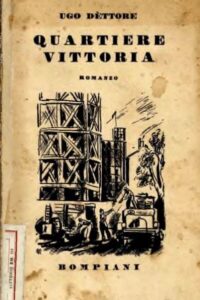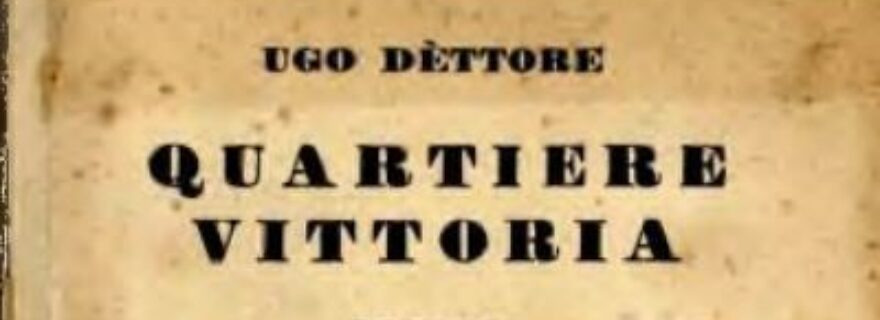Quartiere Vittoria, a Little-Known Italian Novel with German Roots
There are many novels in danger of being forgotten. In this blog, Carmen Van den Bergh sheds light on one of these endangered books: Quartiere Vittoria (1936) by the Italian writer Ugo Dèttore. Van den Bergh will re-vitalize this book by positioning it in the context of European Modernism.
Quartiere Vittoria [freely translated as The Victory District] is the title of a novel that was written in 1936 by young emerging author Ugo Dèttore. Despite its many strengths, the novel is nowadays rather unknown in Italy, let alone outside its national borders. What is even less known about this book is that it has a German background. At that time, in the transition between the 1920s and 1930s, an important novel had just been published in Germany, which is still known today as an emblem for European modernism of the interwar period: Alfred Döblin's Berlin Alexanderplatz. In this blog post we will reveal part of the missing link between this famous German masterpiece and this almost unknown Italian novel.

Quartiere Vittoria by Ugo Dèttore is an extraordinary novel, maybe one of the most curious novels of the Italian interwar period, but the book has, unfortunately, fallen into oblivion and has (for now) disappeared from the debate. The story shows how men and women from three different generations (those who lived before, during and after World War I) needed to adapt to the changing times. As a result, they became more and more shrewd, insensitive and unscrupulous. The novel pinpoints how the struggle of survival can lead people to become harsh and cold, where those who think about their own profit always win from the fair and the honest, leaving little or no room for people’s social and human needs, such as appreciation, recognition, creativity and family values. Between the lines you can read how the city feeds on the energetic warmth of its inhabitants, to become itself (a bit like a vampire) more vital, while the inhabitants become more and more like automatons, losing their unique features and thus becoming unrecognizable from each other. The indirect criticism shows how both taylorism of labour and the failed ideological promises of the ruling classes have led to a sense of futility and self-alienation in society.
The novel is very similar, in terms of content and form, to other innovative novels from that time and therefore it can be placed in the wake of the genre of the Großstadtroman. The real protagonist in this story is undoubtedly the city (as we can immediately see from the toponym in the title); all the other characters rotate around this location. One can easily find clear intertextual references in the story to well-known international modern city novels and cinematographic documentaries of the period, such as Metropolis by Fritz Lang, Die freudlose Gasse by Georg Pabst, Berlin – Die Sinfonie der Großstadt by Walter Ruttmann, etc.
The similarities between the Italian novel of Ugo Dèttore and Alfred Döblin’s masterpiece, Berlin Alexanderplatz, are evident from the very first pages of both books. Both begin in the same manner, “in medias res”, with the image of a passing tram that marks the journey of the main character, who after four years of absence, enters a new, modern world full of color and chaos, and traumatic experiences in the aftermath of the First World War. The big difference between the two novels lies in the ending. In the German novel the city remains unchanged and the main character goes through a real Bildung with a positive outcome. He learns to live in the big city with himself and with the others. Instead, in the Victory District it is the city that takes over and makes a huge transformation. This evolution, however, is a negative one since the neighborhood is moving towards a progressive decay and the characters have become more and more individualistic and insensitive. The narrator, who up to the last moment refrains from explicit judgments, shows an indulgent side in their final remarks, suggesting that the process of expansion and competition between the characters (at all costs) was inevitable and necessary for their survival.
How can we explain such similarities between novels written around the same time, but in different countries? In a letter from 1934 to the editor Valentino Bompiani, the Italian author Ugo Dèttore openly declared that he had found inspiration for writing his book in the translations of novels from contemporary German-speaking writers, such as Mann, Neumann, Feuchtwanger and Wassermann. But in this letter Dèttore underlines that the novel which had impressed him most, from a technical point of view, was Berlin Alexanderplatz by Alfred Döblin.[1] Dèttore had read Döblin’s masterpiece with a lot of admiration and decided to create his own Italian version of the novel, changing the characters, plot, setting and time frame, blending and enriching it with his own ideas and formal experiments.
Quartiere Vittoria can therefore be seen as a great döblinian novel in the Italian language, which is both realistic and expressionistic and able to touch soft spots and dangerous buttons. However, the book has never been canonized by critics, not then, nor by publishers or academics at a later stage, and this is for various reasons: the young age and peripheral position of the author in the literary field, the period in which the book was written, the hazardous themes, as well as the change of taste among literary critics once the fascist period was over.

Quartiere Vittoria is a hidden treasure that is waiting to be reread. For now, the book is only available in Italian but we want to place the novel in a broader context, that of European Modernism. Therefore, together with my colleague, Dorine Schellens, I have started a research project in which 4 research assistants have been appointed. In the coming months we will analyze the novels of Alfred Döblin and Ugo Dèttore in depth, starting with a close reading and a thorough comparison of the texts. We will also set up two digital applications in Carto and Nodegoat, in order to expose a number of differences: with Carto we will perform a text-immanent analysis, tracing the movements of the characters in both novels, while with Nodegoat we will perform a contextual network analysis, in which we examine the differences in reception at national and international level of both books. We hope, in this way, to approach both books from a new perspective, and to bring them back to the fore by questioning their form and content again.
[1] The correspondence between Ugo Dèttore and the publisher Bompiani takes place in the period between 1933 and 1934. The author's letter addressed to the publisher is undated, but the reply from the publisher Valentino Bompiani to Ugo Dèttore is dated November 28, 1934. [Bompiani Publishing House Archive at Rcs MediaGroup, in the correspondence called Ugo Dèttore]. See also Rubino Liborio Mario, La Neue Sachlichkeit e il romanzo italiano degli anni Trenta, in Petroni Franco & Tortora Massimiliano (eds.), Gli intellettuali italiani e l’Europa (1903-1956), Lecce, Manni, 2007, pp. 235-274.
© Carmen Van den Bergh and Leiden Arts in Society Blog, 2022. Unauthorised use and/or duplication of this material without express and written permission from this site’s author and/or owner is strictly prohibited. Excerpts and links may be used, provided that full and clear credit is given to Carmen Van den Bergh and Leiden Arts in Society Blog with appropriate and specific direction to the original content.



0 Comments